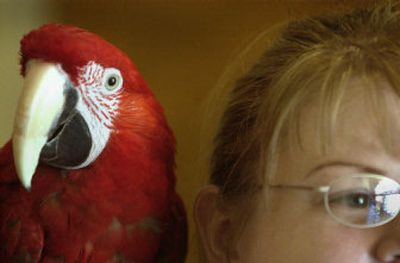Reconsidering the bird’s-eye view

To the untrained eye, Barbara Heidenreich and the sherbet-colored conure twirling before her chest were engaged in a simple dance.
The soft-eyed woman would cautiously step in, offer her winged suitor a sunflower seed, and then step back, the parrot spinning to keep up. They were strangers, yet the longer they proceeded, the more their movements synchronized like the workings of a clock. An audience of two dozen, including the bird’s owner, was awestruck.
Heidenreich, who lives in Texas, is what might be best described as a parrot whisperer, an animal trainer with the gift of communication not unlike that displayed by Robert Redford in a 1998 movie about mending a mentally traumatized horse. Her resumé includes stints with Discovery Island at Walt Disney World and Marine World Africa USA.
She was in Spokane on Sunday to teach parrot lovers how to coax good behavior out of the exotic birds, often misunderstood and written off as temperamental. The seven-hour class at the Corbin Senior Center, 827 W. Cleveland, cost between $50 and $75.
“I think people are really blown away by what’s possible,” Heidenreich said. “A lot of times, people think they have a problem bird when what they need is positive reinforcement.”
In the class, Heidenreich teaches students to reward birds’ good behavior with treats or approval.
The classes are aimed at reducing a growing crisis of parrot abandonment, in part because many owners could no sooner get their birds to twirl on a perch than they could get them to fetch a pail of water. Owners punish the bird with a towel, or a spray bottle or neglect.
Neglected birds can be very noisy and destructive, problems few consider when succumbing to the attraction of a colorfully feathered bird that may talk.
Parrot advocates point out that exotic birds have not had their “wild” characteristics bred out of them like dogs and cats, which have been made docile through thousands of years of controlled breeding. Parrots are either captured wild birds or just a few generations removed.
Also sometimes overlooked at the time of purchase is the parrot’s life expectancy. Larger birds can live 40 to 80 years.
Often, the birds wind up being passed from one unhappy home to another, eventually dying from neglect or abuse. Other parrots are simply turned loose, but rarely survive. The lucky ones are forfeited to parrot rescue groups.
In a typical week, parrot advocate Karin Gibbs of Spokane, who was attending the class, might see two to three parrots forfeited by their owners. The conure that Heidenreich was working with had been rescued just two weeks ago by Gibbs, who cares for about 36 of the birds.
“Probably 75 percent of our birds, people have either lost interest in or they don’t want to pick the mess anymore,” Gibbs said. “Some of these birds live like 60 or 70 years.”
Wally, a green winged macaw, was already 21 years old when Priscilla Sivanish acquired him from a woman who thought she wanted a bird but changed her mind years later after the macaw bit her. His cage became a prison.
“He lived in an attic for 13 years in a 22-inch by 24-inch cage that wasn’t big enough for him,” Sivanish said. “Now he steps up and lets us pet him.”
At Sunday’s class, Sivanish described a parrot’s relationship with its owner as a coupling in which the owner takes the place of the parrot’s lifetime mate. An owner who grows tired of a bird, ignores it or abandons it, can cause considerable psychological damage and lead the bird to self-mutilation.
Gibbs and Sivanish are members of For NorthWest Birds, a group of volunteers assisting parrot rescue and owner education. A list of the local rescue groups is published on For NorthWest’s Website at www.fornwbirds.org/links.html.